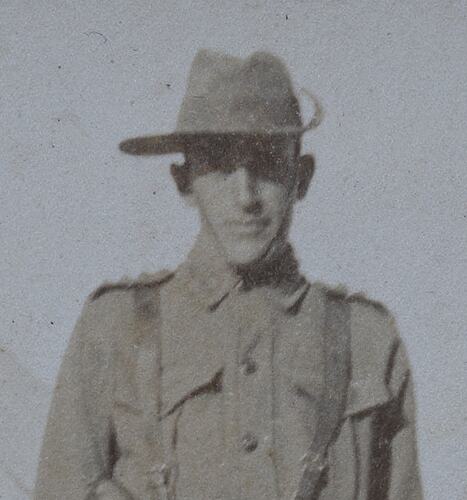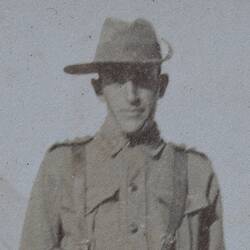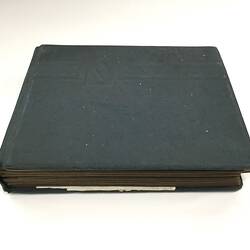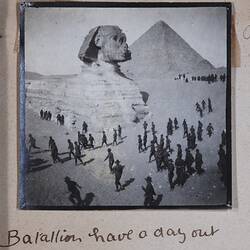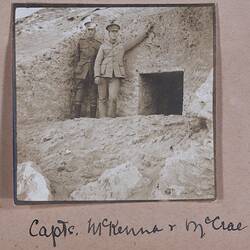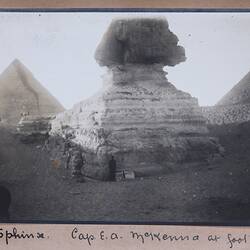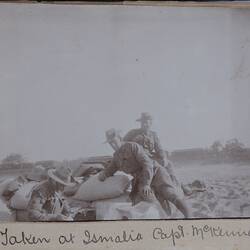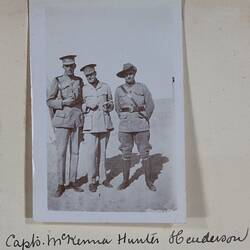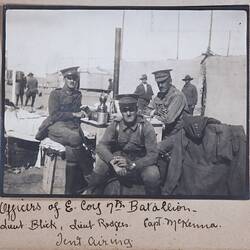Captain Edward Albert McKenna was born on 28 August 1877 in Castlemaine, Victoria. He was the third of six children born to John and Augusta McKenna, both of whom died before the outbreak of World War I. He attended school in Castlemaine, and showed early enthusiasm for the military. The Argus reported that McKenna was 'appointed lieutenant of the 4th Battalion of Infantry in 1900, passing to the unattached list, and later to the 66th (Mount Alexander) Infantry.' He was employed at the store Hicks, Atkinson, & Sons, where he was a department manager in soft goods.
In 1910 Edward married Elizabeth "Lillie" Mary Gibney, who is believed to be the creator of the photo album that showcases the photographs he took whilst on active service during World War I.
Edward described himself as a department manager (softgoods) when he applied for a commission in the Military Forces of the Commonwealth on 17 August 1914. He left Melbourne bound for Egypt on 19 October on the HMAT Hororata. The Argus reported that he left Australia as a captain, second in command of a company in the 7th (Vic.) Battalion (17 May 1915, p.6). (The West Australian incorrectly reported that he was second in command of A Company in the 6th Victorian Battalion (18 May 1915, p.7).) Ross McMullin (2012:25) indicates that Edward was in charge of the 7th Battalion's company from Footscray and the western suburbs of Melbourne. Edward's first few photographs document some of the voyage on the Hororata, whilst the bulk of the images are of his time in Egypt. During the voyage he befriended Captain Geoff McCrae, also of the 7th Battalion. McCrae was to become his closest friend in the next few months.
The Hororata was one of the first convoy of troopships which assembled in King George Sound, Albany, Western Australia, in late 1914 before carrying Australian and New Zealand troops overseas. The convoy left on 1 November.
Arriving in Egypt on 2 December 1914, Edward and the others of the 7th Battalion were quartered at the Mena training camp. During his time in Egypt he took many photographs that depicted the life around camp and also places of interest that he visited in Egypt. On Christmas Eve Edward, Geoff McCrae and eight others held a dinner at Shepherd's (hotel) to commemorate the anniversary of Edward and Lillie's wedding. Geoff was astonished by the display of 'wealth and luxury' there, including an enormous Christmas tree, women wearing glittering jewels and champagne that 'literally flowed in rivers'. (Geoff McCrae, 25 Dec 1914, quoted in McMullin, 2012:29).
Yet action was soon at hand. Edward McKenna took part in the 1st Suez Offensive in early 1915 before travelling to Gallipoli in April 1915. He was a part of the second wave of troops landing at Anzac Cove on 25 April 1915. He led his men away from the beach, up a steep hill. Here, tragically, his leg was blown off and he bled to death. (McMullin (2002: 125; 2012: 40). (Edward's service records list the date of his death as 25-30 April 1915.)
On 3 June the Sydney Morning Herald (p.10) reported that 'Major Edward Albert McKenna, who has died of wounds, had been an officer for 15 years. He was 38 years of age. He went to Egypt as a captain, and in Egypt he became a major.' His death was also reported in the West Australian (28 May 1915, p.7). (His military records show on-going discussion about his promotion to major in Egypt, and whether that had been confirmed at the time of his death.)
Edward was initially buried 'in an isolated grave, Anzac, near the bottom of Victoria Gully, North side, 1100 South East of Anzac Cove', and was later reinterred in the Lone Pine Cemetery, Gallipoli, Plot 2, Row A, Grave 27. In recognition of his services he was awarded the 1914-15 Star, British War Medal and the Victory Medal, all of which were sent to his wife.
Edward's military records indicate that he had an unusually large number of posessions for a soldier (although perhaps more standard for an officer), including seven shirts, a pillow, six towels, a travelling rug, gumboots, pyjamas and slippers. Also amongst his posessions was a camera, and although no photographic prints or albums are mentioned in his military record, his trunk and 'parcels' may have contained them. These may have been left in storage in Egypt - Granville Ryrie, Commanding Officer of the 2nd Light Horse Brigade, records leaving his 'trunks here' [in Egypt] when he left for Gallipoli in mid-May (letter to his wife, 15 May, quoted in Gallipoli Sniper, John Hamilton, p.129). Lillie McKenna received her husband's effects in 1916.
In 1986 Museums Victoria received a donation of two photograph albums believed to have been compiled by Lillie McKenna: SH 040219 and ST 040220. The albums contain 237 photographs, thought to have been largely taken by Edward. The albums were donated by Mr J. Willis of Fairfield.
Edward appears in the following Museums Victoria collection images MM 120380; MM 120389; MM 120396; MM 120432; MM 120486; and MM 050637. He also appears in four images held at the Australian War Memorial: A01134, P05745.001, A01123 and H15590.
A photo essay of Edward's story was released by Museums Victoria in 2025 to commemorate the 110th anniversary of his death on the first Anzac Day: The journey to World War I through the eyes of a soldier - Museums Victoria
References
The AIF Project
Ancestry.com
Australian War Memorial
National Archives of Australia
Museums Victoria supfile ST 040220
Ross McMullin, 2012. Farewell Dear People, Scribe, Melbourne, p. 25, 28, 29, 40.
Ross McMullin, 2002. Pompey Elliott, Scribe, Melbourne, p. 125.
More Information
-
Keywords
-
Localities
-
Authors
-
Article types
